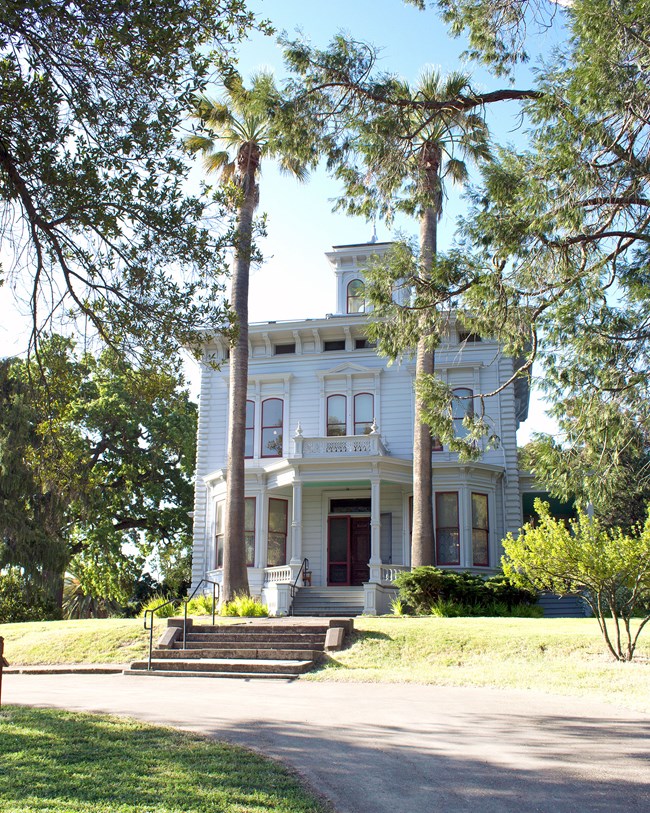Last updated: July 9, 2024
Article
NPS Geodiversity Atlas—John Muir National Historic Site, California
Geodiversity refers to the full variety of natural geologic (rocks, minerals, sediments, fossils, landforms, and physical processes) and soil resources and processes that occur in the park. A product of the Geologic Resources Inventory, the NPS Geodiversity Atlas delivers information in support of education, Geoconservation, and integrated management of living (biotic) and non-living (abiotic) components of the ecosystem.

Introduction
John Muir National Historic Site (JOMU) is situated along the Alhambra Valley in Martinez, Contra Costa County, California. Authorized on August 31, 1964, JOMU encompasses approximately 139 hectares (344 acres) and preserves the home and portions of the agricultural estate where influential naturalist and writer John Muir lived, worked, and is buried (National Park Service 2016). Considered a key advocate and founder of the national park concept, Muir’s political leadership and writings helped establish several early national parks and launched an era of environmental activism that continues today. The historic site interprets the entirety of John Muir, beyond his legacy in wilderness conservation, and is uniquely positioned to explore how societal biases were woven into the system from its origins during Muir’s time and why they continue today (National Park Service 2015a). The historic site is composed of three non-contiguous properties: 1) House Unit, that contains the 1882 Italianate Victorian house where John Muir lived from 1880 until his death in 1914; 2) Mount Wanda Unit, consisting of 132 hectares (326 acres) of rolling hills and footpaths; and 3) Gravesite Unit, that encompasses the Strentzel-Muir cemetery, including the gravesites of John Muir, his wife Louie, her parents John and Louisiana Strentzel, and Muir’s daughter and son-in-law, Wanda and Tom Hanna (National Park Service 2015a; KellerLynn 2021).

Geologic Setting
The bedrock underlying John Muir National Historic Site is predominantly composed of two sedimentary units: (1) rocks of the Cretaceous Great Valley Sequence; and (2) the Paleocene Martinez Formation. Sediments that comprise these formations were shed from the Sierran magmatic arc to the east and deposited in a marine basin associated with a subduction zone on the western margin of North America between 163.5 Ma and 56 Ma. These rocks were laid down before the modern-day transform plate boundary of California existed, at a time when the oceanic Farallon and Kula Plates were converging with the continental North American Plate (Elder 2013). Sandstone, siltstone, and shale (mudstone) of the Great Valley Sequence are widely mapped throughout the core of JOMU and represent a diverse range of depositional environments that include shallow marine, fluvial-deltaic, basin plain, and deep-sea fan settings (Ingersoll 1979; Cherven 1983; Bartow and Nilsen 1990). Marine sandstone and shale of the Martinez Formation are found along the southwestern and northeastern portions of the historic site (Figure 18; Elder 2013).
Regional Geology
John Muir National Historic Site is a part of the Pacific Border Physiographic Province and shares its geologic history and some characteristic geologic formations with a region that extends well beyond park boundaries.
- Scoping summaries are records of scoping meetings where NPS staff and local geologists determined the park’s geologic mapping plan and what content should be included in the report.
- Digital geologic maps include files for viewing in GIS software, a guide to using the data, and a document with ancillary map information. Newer products also include data viewable in Google Earth and online map services.
- Reports use the maps to discuss the park’s setting and significance, notable geologic features and processes, geologic resource management issues, and geologic history.
- Posters are a static view of the GIS data in PDF format. Newer posters include aerial imagery or shaded relief and other park information. They are also included with the reports.
- Projects list basic information about the program and all products available for a park.
Source: NPS DataStore Saved Search 2910. To search for additional information, visit the NPS DataStore.
A NPS Soil Resources Inventory project has been completed for John Muir National Historic Site and can be found on the NPS Data Store.
Source: NPS DataStore Saved Search 2982. To search for additional information, visit the NPS DataStore.
Related Articles
John Muir National Historic Site
National Park Service Geodiversity Atlas
The servicewide Geodiversity Atlas provides information on geoheritage and geodiversity resources and values within the National Park System. This information supports science-based geoconservation and interpretation in the NPS, as well as STEM education in schools, museums, and field camps. The NPS Geologic Resources Division and many parks work with National and International geoconservation communities to ensure that NPS abiotic resources are managed using the highest standards and best practices available.


